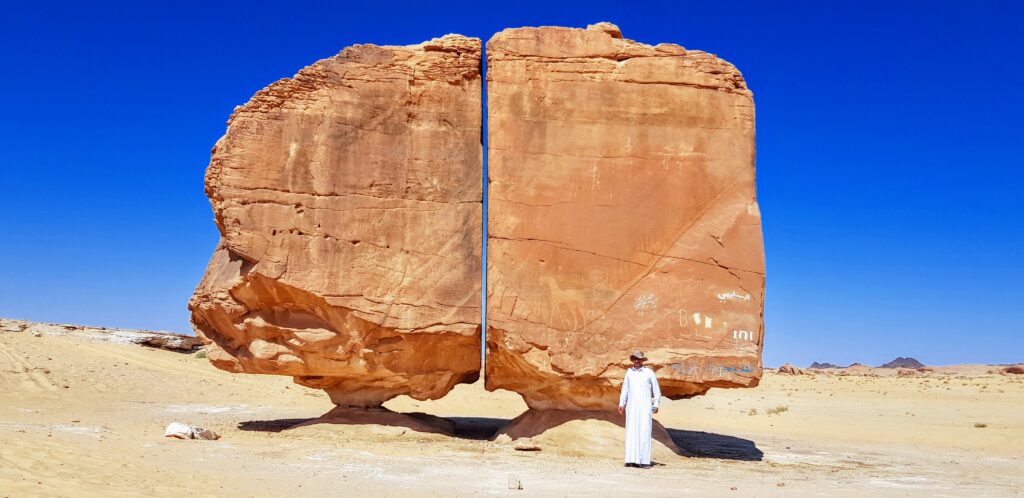In the remote desert landscape of Saudi Arabia’s Tayma Oasis lies an extraordinary geological curiosity that has captivated the minds of researchers and laypeople alike. Known as the Al Naslaa rock formation, this striking natural phenomenon appears to have been effortlessly split in two, defying typical understanding of how rocks naturally fracture and break.

The Al Naslaa formation consists of two perfectly matched halves, separated by a razor-sharp divide that runs vertically through the center. Each side is a near mirror image of the other, with grooves, pits, and textures aligning with eerie precision. It’s as if some colossal force had simply cleaved the rock in two, not only leaving behind an incredible formation, but a lot of questions.
But how did this remarkable split occur? Theories abound, with geologists putting forth a variety of explanations to account for this seemingly impossible feat of nature.
The rock itself is a sandstone slab, which is not uncommon in the desert regions of Saudi Arabia. However, what sets Al Naslaa apart is the sheer precision of its division. The cut is so straight and so clean that it almost appears as if it were sliced with a laser, prompting imaginations to run wild with theories of ancient advanced civilizations or extraterrestrial interventions.
How Did The Rock Split in Two?
Tectonic Forces
One of the most popular hypotheses centers around the role of tectonic forces. The Arabian Peninsula is situated along major fault lines, where the Earth’s shifting continental plates can generate tremendous stresses and fractures in the underlying rock. Over eons of gradual movement, it’s possible that the Al Naslaa formation was slowly torn apart by the relentless push and pull of these immense geological processes.
Water Erosion
Another intriguing idea involves the influence of water erosion. Though the region is now arid, the Al Naslaa site may have once been subjected to periodic flooding or fluctuating groundwater levels. As the rock was gradually worn away, a deep fissure could have formed, eventually cleaving the formation in two through the power of natural weathering.
A Cataclysmic Event
Some researchers have even speculated about more dramatic, cataclysmic events. Could a powerful earthquake or meteorite impact have instantaneously sundered the rock, leaving behind this split-second snapshot of geological drama? The sheer precision of the divide lends some credence to this explosive theory.
Ancient Technology
Of course, not everyone is convinced that natural processes alone can account for the Al Naslaa formation’s unique appearance. A few fringe theorists have proposed the involvement of ancient human technology, suggesting the rock was deliberately split by sophisticated tools or explosive devices. However, the overwhelming scientific consensus points to entirely natural explanations.
Regardless of the precise mechanism, the Al Naslaa split rock stands as a mesmerizing reminder of the raw power and unpredictability of our planet’s geology. This remote desert anomaly continues to captivate all who visit it, serving as a humbling reminder that there is still so much we have yet to uncover about the hidden workings of our planet.

